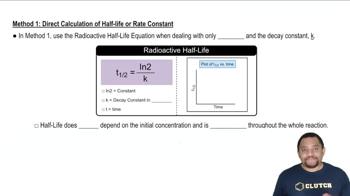(b) Calculate the molar mass of a gas if 2.50 g occupies 0.875 L at 685 torr and 35 °C

The molar mass of a volatile substance was determined by the Dumas-bulb method described in Exercise 10.53. The unknown vapor had a mass of 0.846 g; the volume of the bulb was 354 cm3, pressure 752 torr, and temperature 100°C. Calculate the molar mass of the unknown vapor.
 Verified step by step guidance
Verified step by step guidance
Verified video answer for a similar problem:
Key Concepts
Ideal Gas Law

Molar Mass Calculation

Dumas Method

Calculate the molar mass of a vapor that has a density of 7.135 g/L at 12°C and 743 torr.
In the Dumas-bulb technique for determining the molar mass of an unknown liquid, you vaporize the sample of a liquid that boils below 100°C in a boiling-water bath and determine the mass of vapor required to fill the bulb. From the following data, calculate the molar mass of the unknown liquid: mass of unknown vapor, 1.012 g; volume of bulb, 354 cm3; pressure, 742 torr; temperature, 99°C.
Magnesium can be used as a “getter” in evacuated enclosures to react with the last traces of oxygen. (The magnesium is usually heated by passing an electric current through a wire or ribbon of the metal.) If an enclosure of 0.452 L has a partial pressure of O2 of 3.5×10−6 torr at 27°C, what mass of magnesium will react according to the following equation?
Calcium hydride, CaH2, reacts with water to form hydrogen gas:
CaH2(𝑠)+2 H2O(𝑙)⟶Ca(OH)2(𝑎𝑞)+2 H2(𝑔)
This reaction is sometimes used to inflate life rafts, weather balloons, and the like, when a simple, compact means of generating H2 is desired. How many grams of CaH2 are needed to generate 145 L of H2 gas if the pressure of H2 is 825 torr at 21°C?
